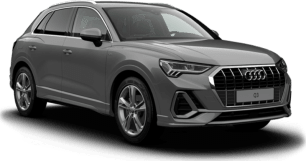We like the practicality in the regular Q3, but is the Sportback too compromised? Let’s take a look
The front two passengers are treated to a spacious and airy cabin, with loads of glass and space for your elbows. You can adjust the height of the centre box to suit your driving position, and there are no complaints when it comes to leg- or headroom.
Tech spills out of the dash and into your hands. USB-A, USB-C and wireless connectivity are available to you. In fact, wireless Apple CarPlay is as revolutionary as keyless entry.
You set it up once and that’s it. Just turn the car on, leave the phone in your pocket and the media system does the rest. The cost is a slight input lag, but the payoff of just being able to throw your phone in the charging bay or simply leave it in your pocket and forget about it is well worth it.
Storage areas are abundant for front passengers with big cupholders with a large centre slot for a phone or wallet perhaps, the large wireless charging bay and a small but useful centre console box.
There are also small bottle holders in the doors and a decently-sized glove box.
A small annoyance comes from the high-resolution screen. Some items become too fine to accurately jab at without taking your eyes off the road, particularly in Apple CarPlay mode. Thankfully all essentials, like the climate and volume controls have physical dials.
Visibility out the front and sides for the driver is fantastic, although there’s no denying the smaller rear aperture in the Sportback’s design makes seeing out the rear a bit more difficult.
Rear passengers are treated to a customizable area. The rear seats are on rails, and I found my legroom to be more than adequate in the standard, furthest-back position. I could have moved the seat about 20 per cent further forward without running into issues.
Height is a different story. I’m 182cm (6.0ft) tall and fit okay with maybe a couple of centimetres space above my head. My slightly taller brother (around 185cm) had his head pretty much up against the roof. The standard Q3 had no such issues, but it’s worth considering if you plan to regularly transport taller family or friends.
The back of the rear seats are clad in plastic which looks nasty but will be good for those with kids, and rear passengers can make use of two USB-C ports, a 12V outlet and dual adjustable air vents on the back of the centre stack.
Boot space comes in at 530 litres (VDA) with all seats in their default positions which proved more than enough for our largest CarsGuide suitcase, some duffel bags, and camera equipment.
It can be adjusted up to 1400L with all the seats stowed. Apparently, this is no less than the regular Q3, which would make sense as the space is meant to be measured to the parcel shelf, before the more aggressive roofline starts to cut its shape.

